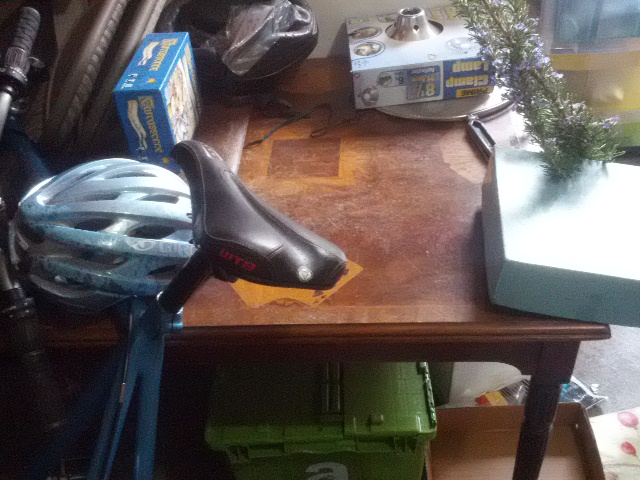Most of my furniture is made either by Ikea or by Darley A. Holbrook. Darley died in 1964, which means that the pieces he made are all verified antiques.
I don’t know when he started making furniture, or when he stopped. One thing I do know is that it was a hobby; he was not a furniture maker by trade.
That was a surprise to me. The pieces he made are put together solidly, sometimes excessively so; some of them have delicate inlays and veneers (which unfortunately made a very attractive clawing surface for my late cat, Happy Fun Ball). That was a real problem for me the last several times I moved, given that he had a taste for a particular style of dining room table that had, in addition to the 4 legs at its corners, two more central legs which made it nearly impossible to simply rotate the table through a doorway. Luckily, it’s been more than 15 years since I last moved, despite statistics which say I would have lived in my first house less than half that time.
Moving Darley’s work has been problematic, and keeping it a bit more so. It requires more care than, say, the Ikea pieces, and in addition to Happy Fun Ball, my two children have done their share of destruction on these antiques. The dining room table we have used since the 18-year-old was under 2 could use some restoration.
The sideboard, which functions as a combination linen cupboard and desk storage in my dining room, was built with complete boxes around each drawer. In other words, you could remove the drawers and use the space as shelves or cubbyholes. In other words, when you remove the drawers in order to move the sideboard, it doesn’t seem to get particularly lighter.
I can’t complain about owning such heavily designed antiques. After all, I haven’t had to buy a dining room table since my college days. The one we used prior to this one was even bigger, and because of the spare leg thing, we separated the two halves and kept them in separate rooms long enough that they warped in slightly different directions, so they could never be perfectly rejoined.
We gave that table to my late grandmother’s dog-walker at the move before last. We liked the idea of him having it, since he’d known my grandmother and Darley was her father, my great-grandfather. That’s why the chairs I recently took to the dump have always been known as The Great-Grandfather chairs.
I feel a little defensive about taking the chairs to the dump, but nobody else in the family wanted them, and I even took the step several years back of getting verbal permission from others in the line of inheritance, all of whom said they didn’t want them and didn’t care what I did with them. I cared, though, and that meant that while one of them that was in beautiful shape has been at Darley’s table for 15 years, the other three were literally gathering dust that whole time. When I finally decided I could let them go, I cried, and I only threw two of them away, since the third had structural integrity.
Now my house is less cluttered, though we still have 3 more pieces of furniture than fit into this house, all taking up space in the garage. One of these is a studio couch I used as my bed for years, then as a couch, then as a bed for each of my children, then once on a stage set. It’s hard to let go of because it was so comfortable to sleep on, and it is so stained now that someone would have to want to reupholster it, and that someone is only imaginarily me. Much in the same way that I have imagined on a regular schedule, about once a year, that I would take the chairs to a furniture repairer for at least an estimate.
We also have a beautiful, enormous coffee table my mother bought in the ’70s, which I own by the right of “primo-grabiture,” that is, because nobody else needed it and I grabbed it up. This thing is so solid you can stand on it, and it’s so big you need about 15 more square feet in your living room than we have in ours.
The third piece is a card table with my grandmother’s initials and three bridge hands inlaid into the surface. There is a card box in pieces that goes with the table, and every so often I put all the pieces in the same place and start to wonder if it’s worth fixing it. The table is a big problem because a person of average height using a chair designed at average height from the ground can’t fit their knees underneath the table. And because of the delicate surface, it’s not really ideal for child use, which never worked too well because child-sized chairs are too low.
Why do I still have the card table? I could say it is because it is or might be valuable (whither goest thou, Antiques Road Show?). I could say it reminds me of my grandmother. I can’t honestly say it reminds me of my great-grandfather, since he died before I was born. By all accounts, he was not very nice to my grandmother. My grandmother herself is a problematic history in our family history, being an alcoholic, schizophrenic manic-depressive (according to the diagnosis of her times).
Getting rid of the extra furniture would create extra space for me, both in the physical realm and the psychic realm. According to some, I would create space for new and better things to come in. In any case, it would be a lot easier to walk through my garage (it’s not really big enough for most cars) and wheel bikes in and out.
If you know someone with the initials EEH, I have a beautiful old piece of furniture you might like to buy. It needs a little restoration but is in remarkable shape, considering that EEH is my grandmother’s maiden monogram and she and my grandfather got married more than 73 years ago. I’ll give you a handwritten provenance testifying to the whole story as I know it, which doesn’t get a whole lot more detailed than this, and I’d leave out all the bits and pieces about my neuroses.
Which must be worth something to me, since I’ve held on to them for so long.

